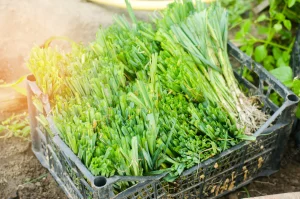How to Grow Leeks: Everything You Need To Know About Growing Leeks!

Leeks are part of the onion family and a member of the perennial crop family, which means they grow for several years rather than being grown as an annual. They are one of the only plants that can be grown in the same place year after year because they have a very shallow root system. Leeks are perfect for growing in small gardens or containers, and they take up less space than most other onion family crops. If you’re ready to add some leeks to your garden this season, keep reading for all the details! Leek care is straightforward, but there are a few things you should know before getting started with planting them. This article covers everything you need to know about growing leeks.
What You Should Know About Growing Leeks
Leeks are biennials grown as an annual, which means they take two growing seasons to reach maturity. The first year they produce a rosette of leaves which store energy and nutrients to sustain the plants during their winter dormancy. In the spring, the plants send up large flowering stalks that are used to create seeds for the next generation. Leeks are frost sensitive, so they should not be planted in spring where winters are cold. Why grow leeks? Leeks offer both beauty and utility. They have smooth, edible leaves and are one of the hardiest biennials. They are easy to start from seed and can be planted in early spring to have them ready in late summer. Leeks are a classic vegetable that are used in many types of cuisine. Their mild flavour makes them a great addition to soups, stews, casseroles, and many other dishes. They can also be eaten raw in salads or sandwiches. Leeks are easy to store, and they can be kept at room temperature for several months.
Which Leek Type Should You Grow?
There are many varieties of leeks, and they vary in shape, colour, and size. Some of the most common leek varieties include American Flag, Giant Musselburgh, Colossal, and Bandor. Here are a few things to keep in mind when choosing which varieties to grow: – Some varieties are better for specific uses. For example, Bandor is well-suited for growing in cold climates. – Some varieties are more disease resistant than others. – Some varieties are more tolerant of pests and weeds.
Where to Grow Leeks?
Although leeks are grown as an annual, they have very shallow roots. Because of this, they can be grown in a wide range of soils, but they prefer a light, sandy loam with good drainage. They do best in full sun, but they will grow in partial shade. – Leeks can tolerate most climates, but they need to be grown in a frost-free environment. – Le-Grow: Leeks grow best when the temperatures are cool.
How To Grow Leeks: Step-By-Step
Here’s a step-by-step process to follow when growing leeks: – Choose varieties: Choose varieties that are best suited to your growing region. – Harvest the soil: Leeks do best when the soil is rich with nutrients, so add some compost or other organic amendments to the soil before planting. – Plant: Leeks can be started indoors or in the garden. – Monitor growth: Water leeks regularly and fertilize if needed. – Harvest: Harvest leeks when they are large enough to use.
Tips For Growing Great Leeks
– Buy seeds from a reliable source: Leek seeds are notoriously slow to germinate, so buy from a source that sells viable seeds. – Sow leeks as early as possible: Leek seeds take a long time to germinate, so be sure to sow them as early as possible. – Protect young plants from pests: One of the biggest challenges of growing leeks is keeping pests away from young plants. – Fertilize regularly: Leeks are heavy feeders that need a lot of nutrients to thrive, so be sure to add fertilizer to the soil when planting. – Harvest leeks when they are large enough to use: Harvest leeks when they are large enough to use. – Save some seeds for the next season: In addition to growing leeks for eating, you can also save a few seeds to grow next year.
Growing Problems With Leeks
– Blossom End Rot: Blossom end rot is a common problem with leeks, especially in warmer climates. – Wilting: Leeks planted in sandy soil are more likely to wilt. – Diseases: Leeks are vulnerable to a few soil-borne diseases, including black leg and club root. – Inadequate water: Leeks need regular watering, but they don’t tolerate standing water in the roots. – Harvesting too early: Be sure to wait until leeks are at least 6 inches tall before harvesting.
Final Words
Leek care is straightforward, but there are a few things you should know before getting started with planting them. This article covers everything you need to know about growing leeks. Now you can get started growing leeks in your garden this season!
